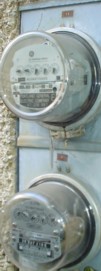Electricity retailing
|
|
Electricity retailing is the final process in the delivery of electric power from generation to the consumer. The other main processes are transmission and distribution.
| Contents [hide] |
Beginnings
Electricity retailing began at the end of the 19th century when the bodies who generated electricity for their own use made supply available to third parties. In the beginning, electricity was primarily used for street lighting and trams.
The provision of these services was generally the responsibility of municipal authorities who either set up their own departments or contracted the services from private entrepreneurs. Residential, commercial and industrial use of electricity was confined, initially, to lighting but this changed dramatically with the development of electric motors, heaters and communication devices.
The basic principle of supply has not changed much over time. The amount of energy used by the domestic consumer, and thus the amount charged for, is measured through an electricity meter that is usually placed near the input of a home to provide easy access to the meter reader.
Customers are usually charged a monthly service fee and additional charges based on the electrical energy (in kWh) consumed by the household or business during the month. Commercial and industrial consumers normally have more complex pricing schemes. These require meters that measure the energy usage in time intervals (such as a half hour) to impose charges based on both the amount of energy consumed and the maximum rate of consumption, i.e. the maximum demand, which is measured in kW.
Monopoly supply
The rapid growth in electric appliances in the early part of the 20th century contributed to an explosive growth in electrification around the world.
The supply of electricity to homes, offices, shops, factories, farms, and mines became the responsibility of public utilities, which were either private organisation subject to monopoly regulation or public authorities owned by local, state or national bodies.
In some countries a statutory or government-granted monopoly was created, which was controlled by legislation (for example Eskom in South Africa).
Electricity retailing in the period from approximately 1890 to 1990 consisted of managing the connection, disconnection and billing of electricity consumers by the local monopoly supplier.
In many utilities there was a marketing function which encouraged electricity usage when there was excess capacity to supply and encouraged conservation when supply was tight.
Creating a market
In 1990 there was a significant development in the way electricity was bought and sold. In many countries, the electricity market was deregulated to open up the supply of electricity to competition. In the United Kingdom the Electricity Supply Industry was radically reformed to establish competition. This trend continued in other countries (see New Zealand Electricity Market) and the role of electricity retailing changed from what was essentially an administrative function within an integrated utility to a become a risk management function within a competitive electricity market.
Electricity retailers now provide fixed prices for electricity to their customers and manage the risk involved in purchasing electricity from spot markets or electricity pools. This development has not been without casualties. The most notable example of poor risk management (coupled with poor market regulation) occurred in California in the summer of 2001, when Pacific Gas and Electric and Southern California Edison were driven into bankruptcy by having to purchase electricity at high spot prices and sell at low fixed rates.
Customers may choose from a number of competing suppliers. They may also opt to pay more for "green" power, i.e. electricity sourced from renewable energy generation such as wind power or solar power.
An electricity provider is often known as "the electric company" or "the power company".

